The Angling Trust and the Environment Agency are working with local angling clubs to combat poaching and fish theft.

The Angling Trust and the Environment Agency are working with local angling clubs to combat poaching and fish theft.

The South West Fly Fair makes a welcome return to Roadford Lake on Sunday 23 February.
The fair is hosted by charity South West Lakes Trust at Roadford Lake, between Launceston and Okehampton. The event is a highlight in the Westcountry’s angling calendar ahead of the new trout fishing season.
The day is made possible thanks to sponsorship from Turrall, Chevron Hackles and Snowbee.

Throughout the day there will be fly tying demonstrations from local and national expert Charles Jardine, with a chance to ‘have a go’, as well as the opportunity to pick up useful tips and valuable advice from other experts.
Other activities include casting demonstrations, fly casting lessons, and a chance to speak to trout, sea and coarse fly fishers.
There will be a live trout cooking demonstration from Gary Champion as well as the opportunity to meet members of fly fishing clubs based at lakes across the South West and find out more about coaching and tuition available in the region – perfect for both newcomers to the sport and experienced anglers feeling a little rusty after the closed season.
Trade stands will be selling new and used tackle and equipment and food and drink will be available at the onsite café.
Book in advance to avoid disappointment. Entry is £7 for adults (£10 on the door) and free for under 18s. Entry includes car parking and a raffle ticket. Tickets are available fromwww.swlakestrust.org.uk/trout-fishing
All attendees to the event will be offered a 10% season ticket discount.
For more information please contact South West Lakes on 01566 771930 or email [email protected].

Over the past twelve months or so I have helped introduce the film Riverwoods to audiences across North Devon. The film highlights the vital link between tree’s and salmon within complex ecosystems. So when I learnt that West Country Rivers Trust were holding a tree planting day beside the River Barle close to the iconic Landacre Bridge I felt that I should attend and join this effort to improve this environment for the salmon.


Those who follow my posts on North Devon Angling News will know of my dismay at the dramatic decline in salmon populations across the UK and beyond. I have been visiting the River Barle since I was a child when I would play in the cool clear waters fascinated by the minnows and trout that darted to and fro. Later I fished for Salmon inspired by the writings of previous generations who enjoyed an abundance hard to imagine today. Thirty years ago I walked the bank in late Autumn to glimpse salmon huddled in deep pools prior to spawning.
It is poignant to reflect upon the plight of Exmoor’s salmon an iconic symbol of the Rivers health and the wider indicator of our planets health. The river is in trouble these flowing waters that teamed with life are dying and it is up to us to reverse this trend.


Our son James works with the National Trust’s wetlands team across North Devon and joined me as a volunteer. We took photo’s as we planted tree’s that will hopefully be there in twenty years or so when our granddaughter can perhaps visit to see where her grandad looked to the future. It is my hope that salmon will still be migrating to the Barle then as they have done for thousands of years.



There’s an old cliché that, ‘salmon live in trees’ but there is a deep and intertwined relationship between these fish and the vegetation that symbiotically supports both, not just the salmon. For trees, salmon bring rich nutrients from the sea up with their migrations to their spawning grounds. Numbers vary by ecosystem and health of salmon populations, but in some areas it has been observed that up to 70% of all nitrogen in trees comes from these migratory fish. This is reciprocated and for salmon, trees provide richer feeding opportunities through falling terrestrial insects and bolstering aquatic ecosystems with leaf and coarse materials for aquatic insects. Not only this, but trees provide resilience against climate change, through evapotranspiration and shading, vital in Southern England as climate threatens the already endangered Atlantic salmon. The benefits continue, as when trees succumb to the wind or are dragged in by beavers, the woody material aids natural processes in forming river stability and forming scours and complex habitat, all of which provides refuge for all different life stages of fish.
The view of the Barle valley from Landacre bridge is a treasured site for many local to or fond of Exmoor. This area is a site of Special Scientific Interest, both for the species-rich mire found within the floodplain but also for our friend the Atlantic salmon. The Barle is an area still supporting high numbers of spawning fish within the Exe despite declines across the catchment and has some of our highest annual electrofishing results for juvenile salmon each year. Despite the picturesque scene, this area is vulnerable, with high browsing from red deer and cattle leaving the banks bare of vegetation, and now showing signs of erosion that left unchecked would leave this very valuable area degrading further.
It was with this concern that we decided to step in with our ‘Trees for Salmon’ planting at Landacre Bridge. Supported by advice from Exmoor National Park Authority (ENPA), we set about a strategy of ‘applied nucleation’, whereby small clusters of trees are planted to act as a dense source of future tree recolonisation. This has the added benefit of small enclosures deterring deer from munching vulnerable young trees, the leading cause of the lack of vegetation in these parts. The work was funded through Natural England’s Species Recovery project and site visits and collaboration with their team allowed us to target our planting exclosures in areas that would not negatively impact the mire habitat but bring about an overall improvement in the long-term hydrology and habitat function at this location. Being such boggy ground doesn’t make the job easy however, with the team from Three Atop Woodland Services manually installing the tree protection exclosures, even through the worst of this winter’s blizzards. All of this was wonderfully supported by the enthusiastic permission and help of the landowner Jo, who has been watching and caring for the salmon in these headwaters for many decades.

With all that goes on behind the scenes, it was with relief that we were able to bring 1,500 young trees and a cheerful group of volunteers to Landacre Bridge on Sunday the 9th of February – the sun was even shining! After some words about the importance of the area and purpose of the day from local angler, Ueli Zellweger, and able demonstration from the WRT tree planting ninjas, Jay and Rob; the group of 25 dispersed across the valley to put trees in the ground at the exclosures. A mixture of native broadleaf trees were planted in, with sessile oak, alder, rowan, blackthorn and hawthorn forming this future riparian woodland community. So able and enthusiastic were our volunteers that by lunchtime, hot leek and potato soup in-tow, all of the trees had already been planted! After some warm bowlfuls and more fishy conversation, folks made their way back on home and the truck was loaded to return to the yard, 1,500 trees lighter. Though the effects of the hard work will take time to see, I look forward to returning to seeing these same plants in a couple of decades and the opportunities that they provide for the river ecosystem. Against the ongoing declines in biodiversity, most evident in freshwater migratory fish of all vertebrate groups; the day offered a positive opportunity to put boots on the ground, get mud under the fingernails and do something about it. We hope for many more opportunities to do the same again and scale up these restoration activities to support our wonderful rivers.
Dr. Dan Osmond
Senior Fisheries Scientist
Westcountry Rivers Trust












A cloudless blue sky, bright sunshine a cold east wind and frosty margins; conditions that are generally not good for fishing with one exception perhaps? Winter trout fishing in small still-waters is often at its best during the winter months and when few other fish are prepared to feed the inhabitants of these calm waters can provide exciting sport if you get the tactics right.
I arrived at Bulldog Trout fishery for a leisurely start at around 9:30am and after chatting with fishery owners Nigel and Tom Early I grabbed my already set up gear. My standard set up for Stillwater trout consisting of a 10’ 7-weight , Snowbee Diamond 2 Fly Rod, Spectre Reel, XS- plus Spectre Floating Fly Line an 8lb b.s Fluorocarbon leader and an Olive damsel nymph.
A pure white egret glided close by alighting upon the bare branch of a riverside tree. Buzzards were gliding high above the valley in the vivid blue sky rekindling memories of the osprey I had seen at the fishery last Spring.
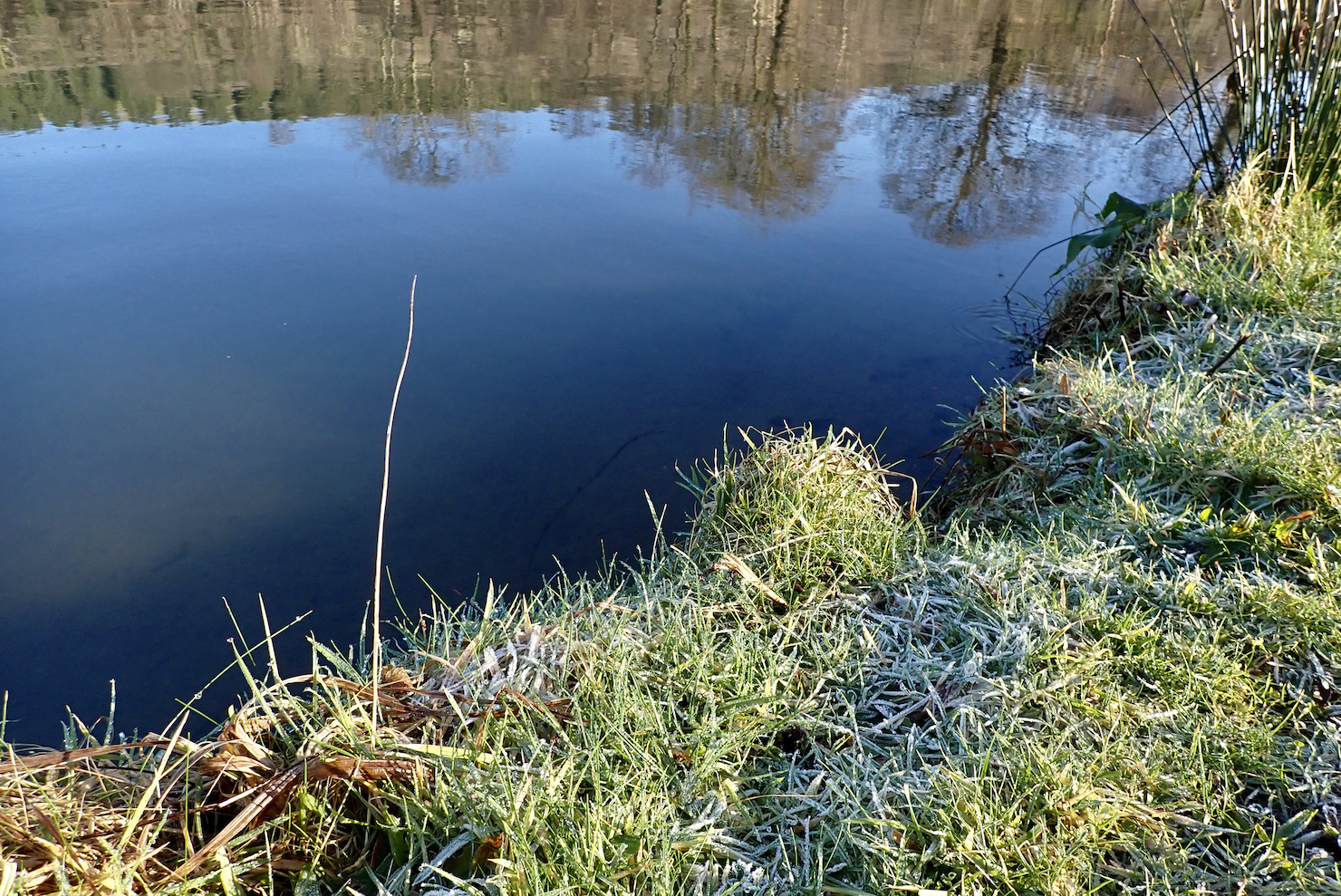
I walked the bank peering into the crystal clear water hoping to spot a trout in the margins. I chose a platform that allowed me to put a line out onto water without casting my shadow. I expected a take at any moment but the trout proved elusive as I explored various swims around the lake.


The electric blue flash of a kingfisher caught my eye as it darted across the lake, quickly followed by a second bird that I was able to focus on as it sped past.
I moved to the windward bank and tied on a bright yellow damsel Nymph/lure. Casting out I allowed the gold headed fly to sink before beginning an erratic retrieve. The line zipped delightfully tight, the rod hooped over and a chunky rainbow of around 5lb tested the tackle. It’s always good to get that first fish in the bag avoiding the blank.


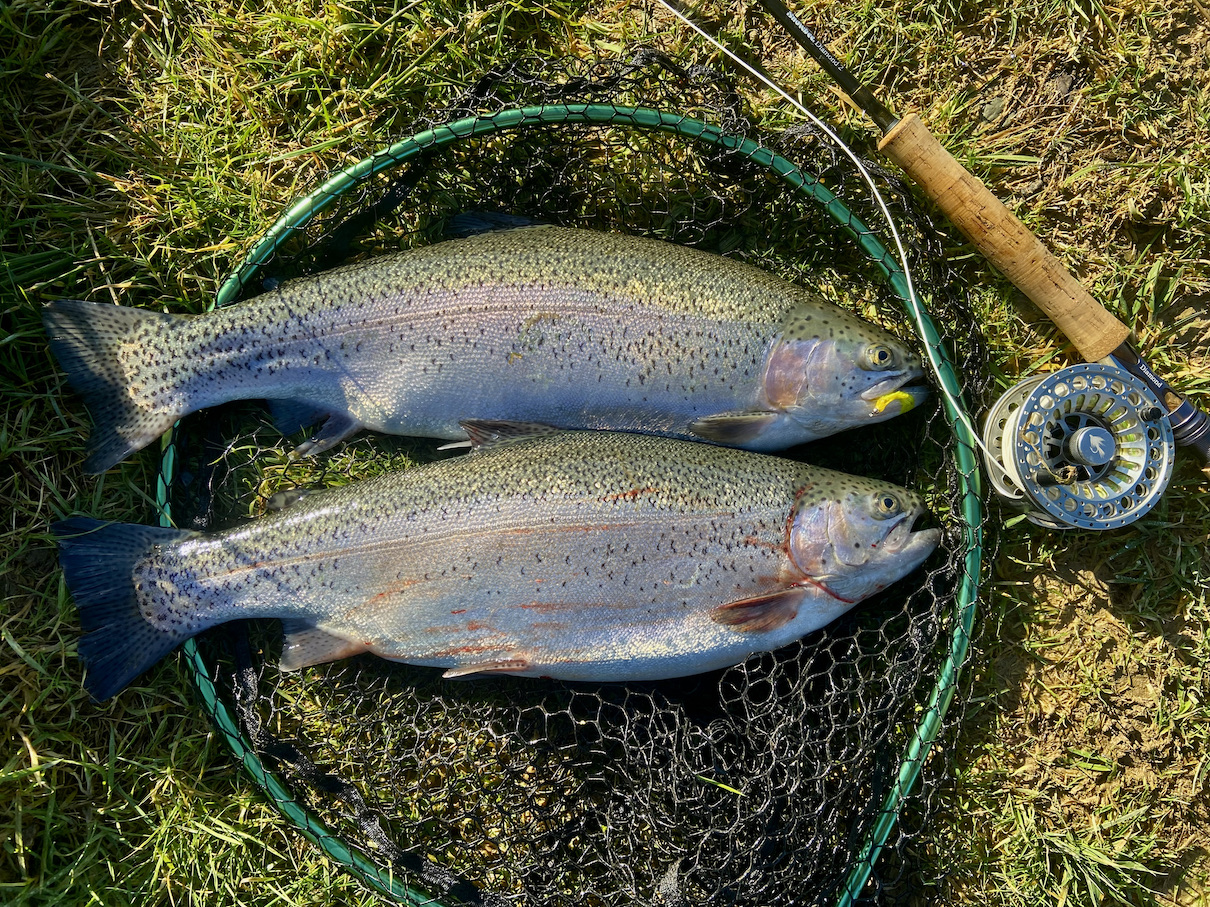
It did not take too long to get the second fish another rainbow that was almost a twin of the first. Confidence in the lure now cemented I fished on and soon added a third rainbow of a couple of pounds.
It seemed to go a bit quiet and my luck took a turn for the worse as over the next hour I hooked into three hard fighting trout that all shed the hook after prolonged and spirited tussles. I checked the hook that appeared to be razor sharp and in good order. Feeling that I needed a change I swapped to a green, yellow and black damsel. After five minutes working this lure deep and slow the line once again zipped tight as another good trout attempted to shed the hook. This one was fighting deeper and shaking its head vigorously and I was delighted to eventually slide a fine tiger trout over the rim of the waiting net.

With four trout in the bag I was content with my days sport but as always there is that desire to complete a limit bag. It was now mid-afternoon and as is often the case the trout appeared to have switched off.
It was perhaps a good time to have a walk around the lake trying different areas. There were two other anglers on the lake and they had both caught rainbows in the 3lb to 4lb size range but like me were not finding the fish easy to tempt.
A walk around the lake failed to inspire as I had a feeling that most of the trout were lurking in the windward side of the lake. So I headed back to the area from which I had enjoyed success earlier in the day. Much of my fishing is determined upon a hunch and a feel for where the fish will be. The occasional fish was also rising in this area prompting me to try a short time with a slow sinking daddy longlegs a pattern that often tempts a trout at Bulldog.
After a couple of chances a rainbow of perhaps 2lb 8oz took my PTN fished on a dropper bringing my total to five fish. Deciding that with the sun sinking below the tree line it was a good time to pack up and gut the trout. A welcome facility at Bulldog is a fish preparation area where you can gut and fillet the catch removing the need to do so at home.
As I returned to the car Brian Sedgebeer was playing a good trout that had succumbed in the fading light of the day.
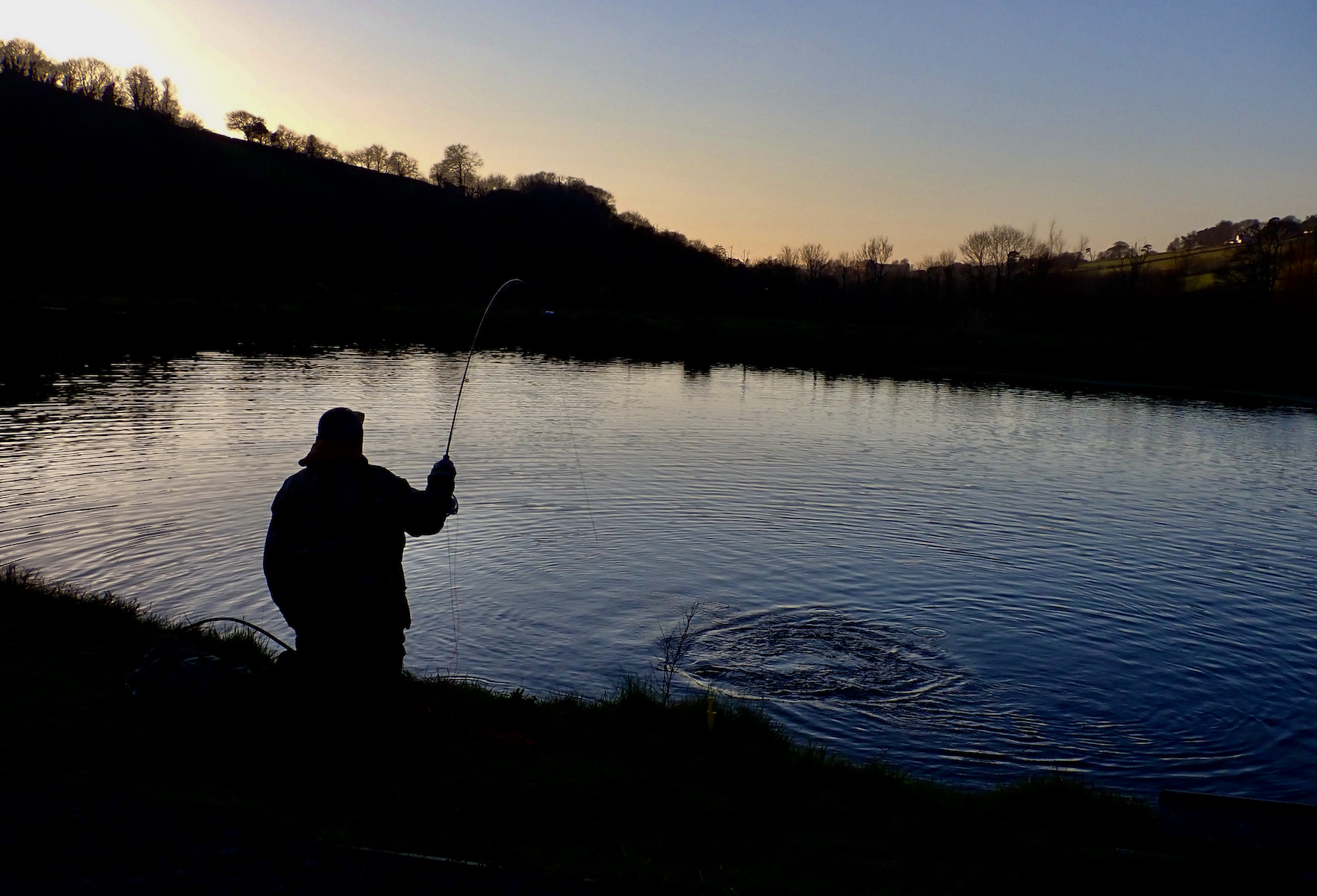
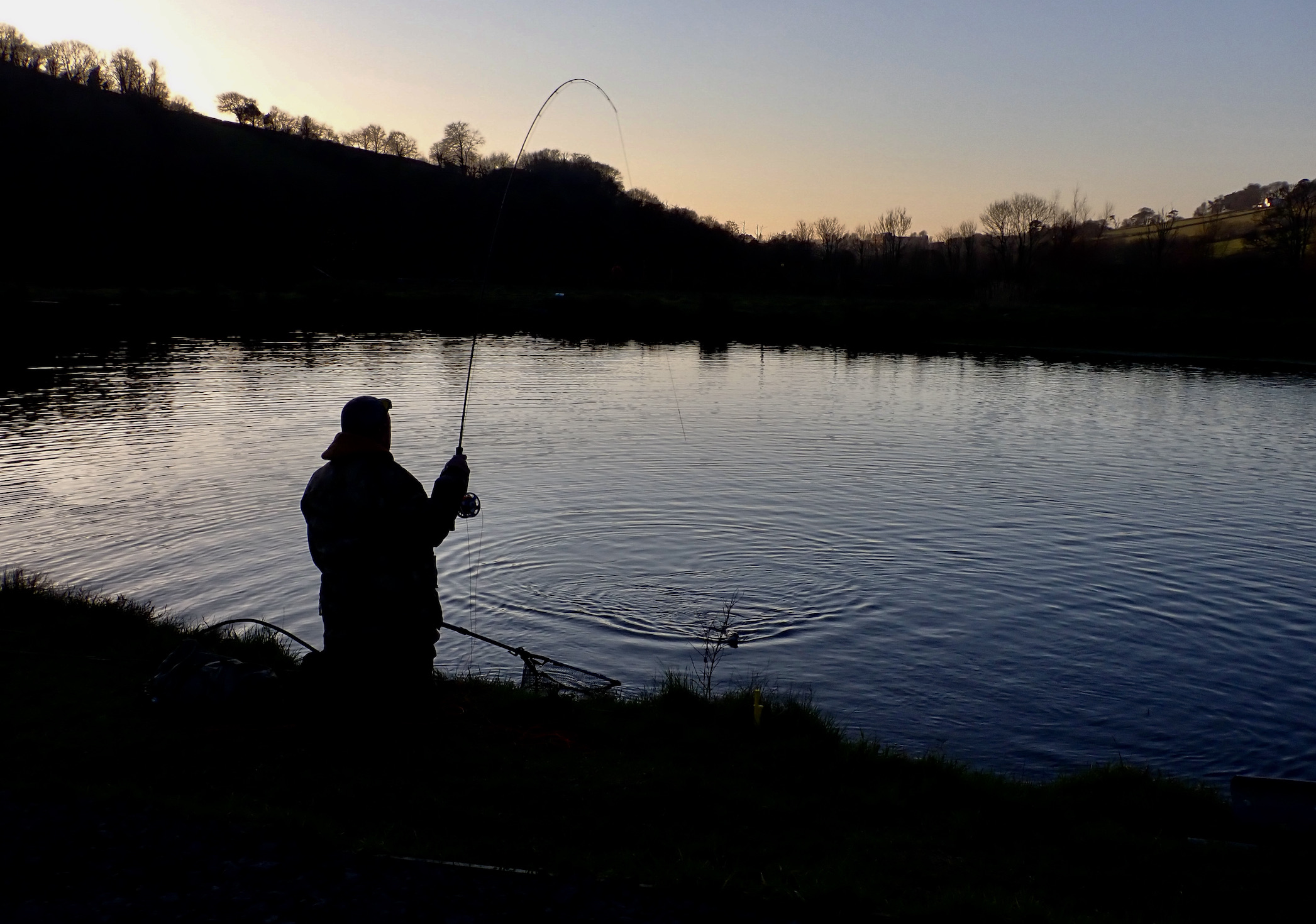
Bulldog Fishery is now a premium trout water that offers superb sport with a very good average size of stocked fish. I have found that the Bulldog trout seem to respond well to larger lures with small imitative tactics less successful. This may of course change during the warmer months when fish become more active feeding closer to the surface. A floating line with a long leader or an intermediate line will generally cover all days at Bulldog as the fish are seldom lurking close to the lake bed.

The spurdog season got off to a flying start off Ilfracombe where John Barbeary took anglers to deep water marks last Sunday. The party of seven anglers boated close to one hundred spurdog the biggest weighing 20lb with many double figure fish. Many thanks to Mike Spiller for providing these images.
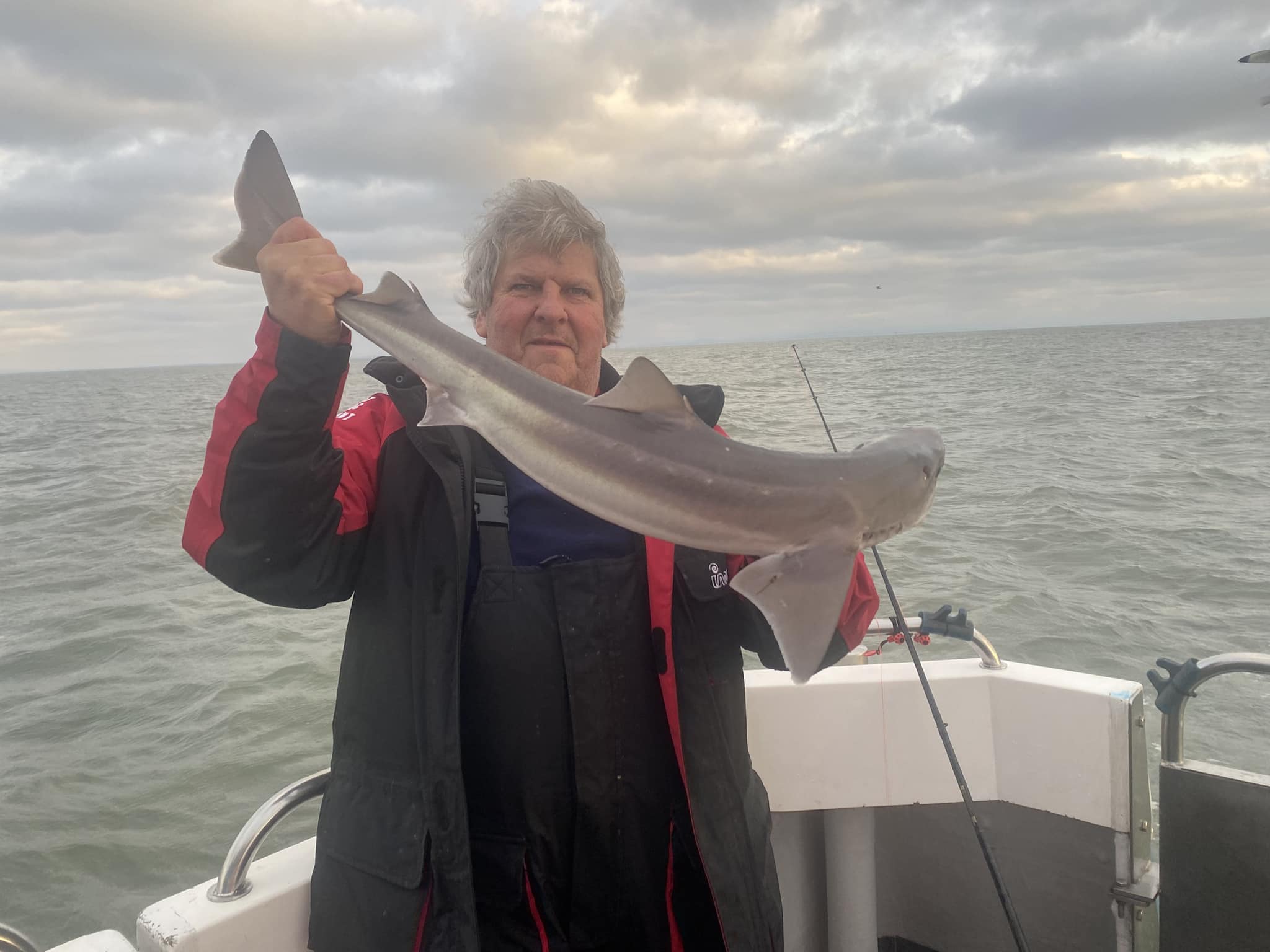

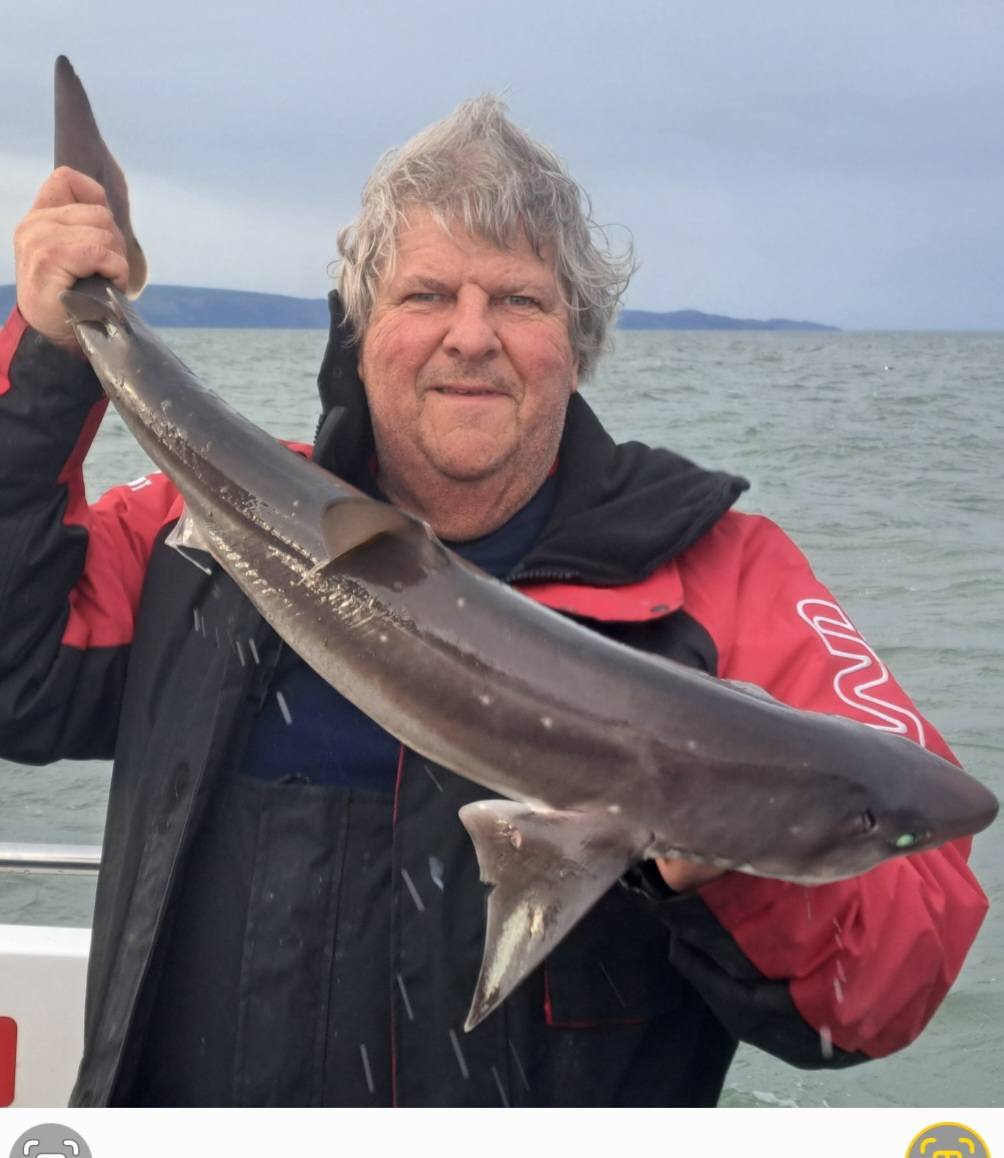

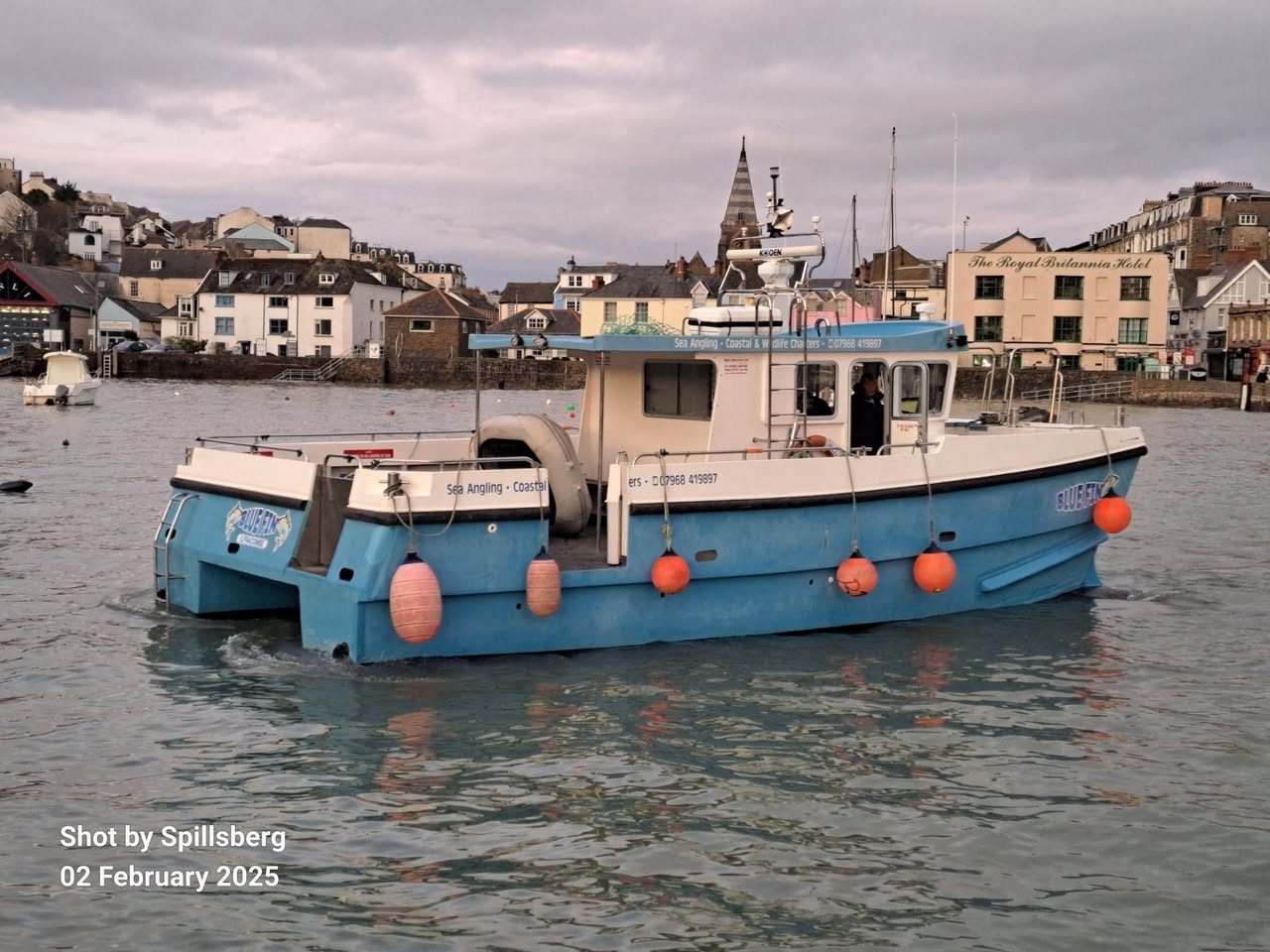



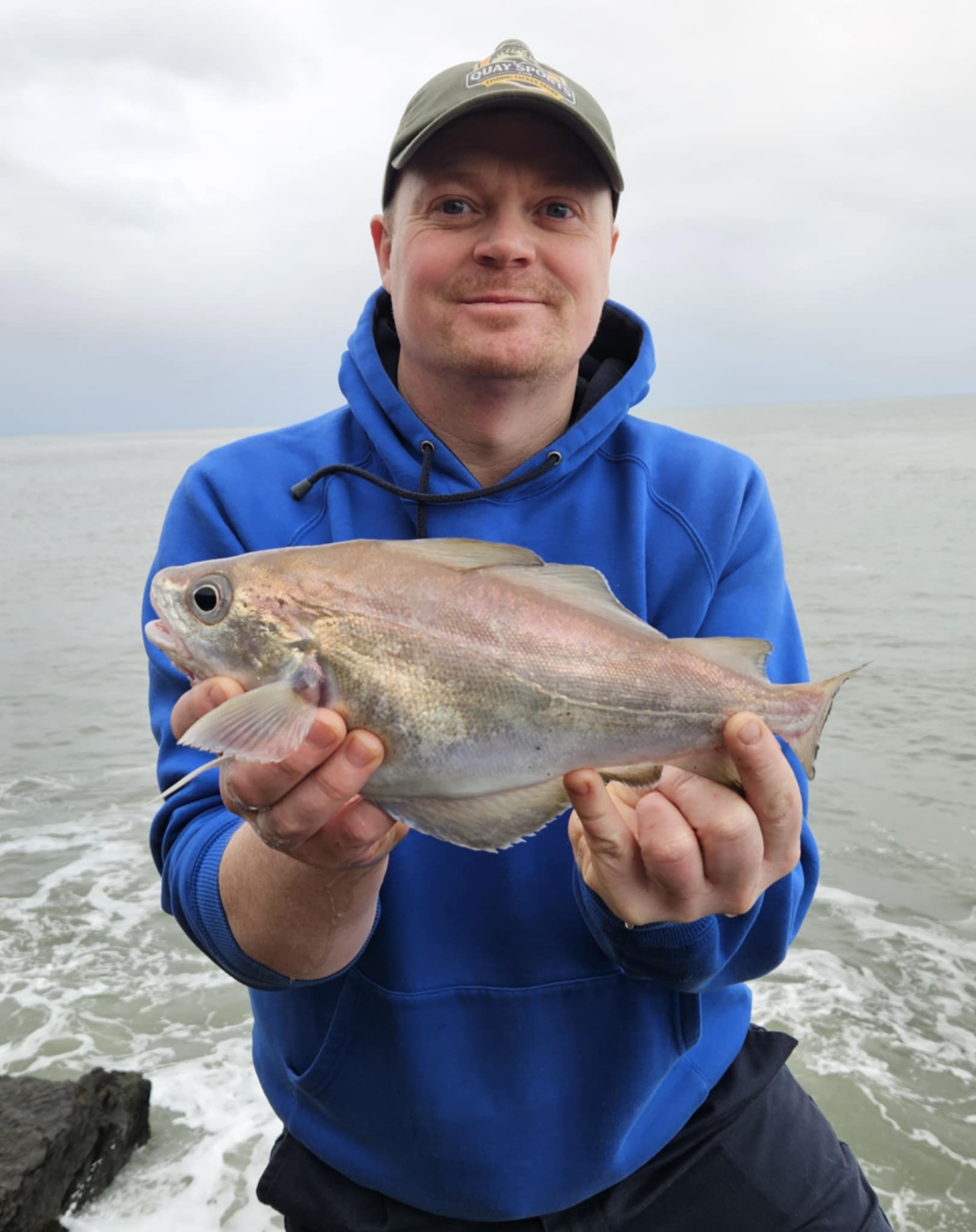
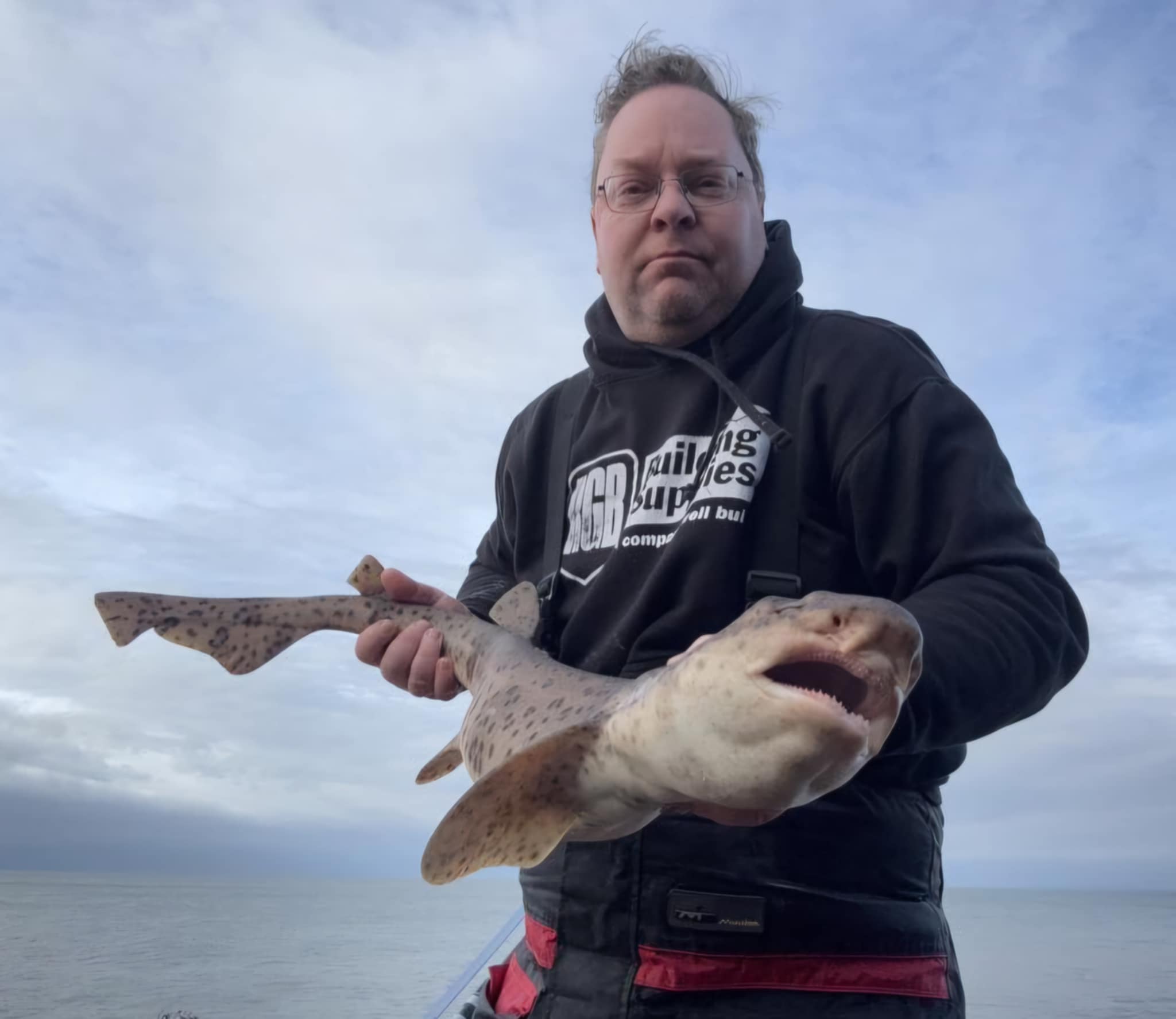

The South West Fly Fair makes a welcome return to Roadford Lake on Sunday 23 February. The fair is sponsored by Turrall amongst others, and is always a highlight in the region’s angling calendar.
The day will include:
Bring the family along too – plenty of activities for all ages. Bring your bikes and wellies to explore the lake.
Entry is £7 for adults online in advance (£10 on the door) and free for under 18s. Entry includes car parking and a raffle ticket.
Book in advance to avoid disappointment!
https://www.swlakestrust.org.uk/south-west-fly-fair-2025-trout





